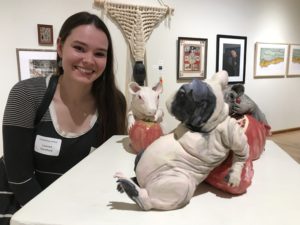First P lace Winner: Lauren Sanford, “Pick of the Paramour”, stoneware, underglaze, gloss (left)
lace Winner: Lauren Sanford, “Pick of the Paramour”, stoneware, underglaze, gloss (left)
Second Place Winner: Gail Coulson, “Polka”, oil on canvas
Third Place Winners (2): Jon Klein, “Dusky-footed Woodrat”, photograph on metallic paper; Judy Pfeifer, “Harbor Series #2”, oil on canvas;
Judges Choice Award: Barbara Johannes, (digital art based on original photo), Mark Chase (brass, copper, wood, mineral spheres), Eleanor Moss Rock (anagama fired ceramic), John Stickney (bass wood and ink carving), Caroline Holmes (mixed media on canvas).
Judges Choice Award: Barbara Johannes, (digital art based on original photo), Mark Chase (brass, copper, wood, mineral spheres), Eleanor Moss Rock (anagama fired ceramic), John Stickney (bass wood and ink carving), Caroline Holmes (mixed media on canvas).
NCAG Salon Founders Award: Jennie Henderson.
Best Collage: Polly Hutcheson
The complete list of entries and winners can be found here.
2018 Salon des Refusés Judges
 About Judge Evan Hobart
About Judge Evan Hobart
Evan Hobart was introduced to clay as a young child in 1993, when he participated in a ceramics after-school art program in the San Geronimo Valley in West Marin.
Evan received his Bachelor of Arts from Humboldt State University in 2004 under the tutelage of Keith Schneider, Jim Crawford and Louis Marak. He completed his Graduate Degree from San Jose State University in 2011 working with Stan Welsh and Monica Van den Dool.
Hobart has taught ceramics at San Jose State University and Medicine Hat Community College, as well as private classes at Sweet Spirit Ceramic Studio in San Rafael, California. From 2011-2012 Hobart was an Artist in Residence at Medalta in Medicine Hat, Alberta, Canada.
Evan is currently the Ceramics Program Manager at the Mendocino Art Center. Evan is also the ceramics professor at Mendocino College in Fort Bragg. Hobart’s work is exhibited in the USA and Canada, and is represented in many private collections throughout California.
The Gualala Salon is made possible by the generous donations of
Sharon Nickodem, Roland Stoughton, Miriam Owen, Bonnie Saland, and other notable sponsors.

The annual Gualala Salon & Salon des Refusés is a juried and judged fine art exhibit showcasing outstanding visual art and artists without regard to the type of media.
The annual Salon & Salon des Refusés is the largest exhibit at Gualala Arts aside from Art in the Redwoods; it has the largest number of entries of any other open call show and fills both the Burnett Gallery and Elaine Jacob Foyer. The Salon is sponsored by generous donors; not by Gualala Arts or the North Coast Artists’ Guild. Many artists save their best new art for this exhibit, as the Salon has gained much notoriety as a judged show by well-qualified people in the arts one that provides significant awards.
As per tradition, the judges decide what artwork is accepted into the Salon exhibited in the Burnett Gallery. The art not juried into the Salon by the judges is displayed in the Salon des Refusés (Rejected) located in the Elaine Jacob Foyer. Thus, all artwork submitted into the show will be exhibited at Gualala Arts. Which artists are selected into the Salon is a tightly kept secret until the opening night.
As in previous years, significant prizes will be awarded to first, second and third best art piece. This year’s monetary awards are first prize of $1,000, second prize of $750, and third prize of $500. The People’s Choice awards in the Salon des Refusés are first prize of $100, second $175 and third $50. The award for Emerging Artist Under 18 years of age is $100.
The original Salon des Refusés was an art exhibition that took place in Paris in 1863, showing works that had been rejected by the official Paris Salon conservative judges. These judges represented the French Academy and were advocates of traditional, orthodox style of painting and sculpture. In 1863, they rejected almost 3,000 pieces of work which resulted in loud protests by the artists. Emperor Napoleon III, ever sensitive to public opinion, ordered a new exhibition to be organized – dubbed the “Salon des Refuses” – in order for the public to judge the merits of the artwork themselves.
In the spirit of the original Paris Salon des Refusés, all visitors will be able to vote for the “People’s Choice” awards. In fact, many artists prefer to be selected as a “reject” to receive the public’s opinion!
History and inspiration of the Paris Salon
Gualala Salon has its origins in the annual Paris Salon sponsored by the French government and the Academy of Fine Arts. The Salon began in 1725 and became a showcase of the best academic art. A medal from the Salon was assurance of a successful artistic career; winners were given official commissions by the French government, and were sought after for portraits and private commissions. In those days exhibiting in the Salon was one of the only means artists had of marketing their work and therefore exclusion from its annual selling exhibition threatened their reputation and livelihood.

In 1748, a jury of awarded artists was introduced. From this time until 1890, the Salon was considered the greatest annual or biannual art event in the Western world. The Salon exhibited paintings floor-to-ceiling and on every available inch of space. Printed catalogues of the Salons are primary documents for art historians. Critical descriptions of the exhibitions published in the gazettes marks the beginning of the modern occupation of art critic.
The Gualala Salon and corresponding Salon des Refusés are inspired by the original Salon des Refusés held in 1863 of the refused artwork by the official Paris Salon. The exhibition was ordered by Emperor Napoleon III after the outcry caused by the number of rejections. The increasingly conservative and academic juries were not receptive to the new Impressionist painters, whose works were usually rejected, or poorly placed if accepted. Some were rejected from the ‘official’ exhibition because their works were considered by the committee too subversive and some even thought that these artists posed a danger to society.

In 1863, artists and their supporters protested vehemently after so many paintings were rejected; only 2,217 paintings out of the more than 5,000 submitted were accepted. Eventually to quell the furor, Napoleon came to view the rejected works and then asked the committee to reconsider its selection. When they refused, he decreed that the public be given the opportunity to view them in a rival exhibition and a tradition of Salon des Refugés was born.
More than a thousand visitors a day visited the Salon des Refusés. The journalist Emile Zola reported that visitors pushed to get into the crowded galleries where the refused paintings were hung, and the rooms were full of the laughter of the spectators. Critics and the public ridiculed the refusés, which included such now-famous paintings as Édouard Manet’s Déjeuner sur l’herbe and James McNeill Whistler’s Symphony in White, No. 1: The White Girl.
Claude Monet, Camille Pissarro, Pierre Auguste Renoir, Alfred Sisley, Edgar Degas, Paul Cezanne, and Berthe Morisot were also participants in the first Salon des Refugés. This exhibit legitimized the newly emerging forms of avant-garde art, and paved the way for the even more shocking style of Impressionism. Ironically the artists included in the officially sanctioned 1863 Salon have completely disappeared and their work remains in obscurity.
We respect the Gualala Salon judge’s decisions and understand that being selected to exhibit in the Gualala Salon Exhibition is a great honor and privilege, and we also understand that the Burnett Gallery space is limited and a lot of good artwork has to be rejected. We want those works to still be on show throughout Gualala Arts Center as part of the Salon de Refusés. We hope this rather novel approach will appeal to the judge, the artists and to the audience!
 Gualala Arts Promoting public interest and participation in the arts since 1961
Gualala Arts Promoting public interest and participation in the arts since 1961